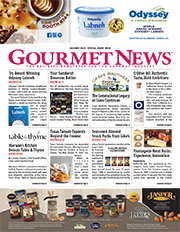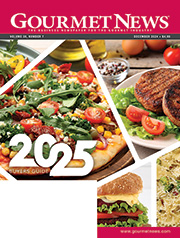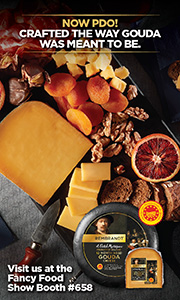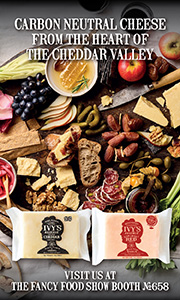
Featured Stories
Retail Foodservice Offers a Gold Mine for Grocers
By Lorrie Baumann
American consumers have decided that they want good food on their schedule, and they’ll eat it wherever they can get it. Their grocers are eager and increasingly able to provide that for them, and their customers are loving them for it.
So says Wade Hanson, a Principal at Technomic, who presented the company’s market research on this subject during a “Foodservice at Retail” conference presented during the National Restaurant Association’s annual trade show in May. Technomic has 50 years of experience tracking market trends for the restaurant industry, but over the past decade or two, the organization has directed its attention to foodservice wherever it occurs and has been in the ideal position to observe the phenomenon as American consumers began looking for new avenues for their food as the Great Recession put previous options out of their financial reach. It was at that time that the grab and go case at local grocery stores became top of mind as an alternative to fast food restaurants, which were increasingly seen as both unhealthy and unappetizing choices. “We’re in a very different world right now as far as retail and foodservice are happening,” Hanson said.
For grocers, the Great Recession has changed the market landscape as well: center store sales are declining, convenience stores have become more vigorous competitors for Americans’ food dollars and the grocery retail industry is consolidating through mergers and acquisition activity. “Retail foodservice has been the major beneficiary of these changes,” Hanson said. “Retail foodservice is really in transition, but poised to be in a very good position.”
For purposes of their analyses, Hanson and Technomic divide supermarkets into three basic tiers: the foodservice specialists, destination supermarkets and supermarkets with prepared food departments that may consist of extended deli counters offering sliced meats and cheeses. About 10 percent of supermarkets fit into the foodservice specialist category, which offer warm ambiance for in-store diners, an extensive array of cuisine and perhaps a checkout area that’s dedicated to foodservice. About 25 percent of supermarkets fall into the destination supermarket category in which the stores are positioned as full-line grocers with good foodservice options. About half of today’s supermarkets fall into the tier that Technomic defines with prepared food departments, and many or most of them are currently looking at moving up a tier to the destination supermarket category, according to Hanson.
At the same time, convenience stores are also aggressively moving toward more premium foodservice options, he noted.
Consumers are embracing these foodservice options offered by supermarkets. In the decade between 2006 and 2015, the annual growth rate for retail foodservice was 10.4 percent, compared to a 2.1 percent growth rate for conventional restaurants. On a dollar basis, the money that consumers spent for supermarket foodservice during that period went from $12.5 billion to $28 billion. Today, supermarket foodservice is a bigger business in the U.S. than K-12 school foodservice, college foodservice or all health care foodservice. “Consumers are seeing more and more value in what they’re experiencing with retail foodservice,” Hanson said. In particular, consumers say that what they spend on a meal in a grocer’s foodservice department is comparable to what it would cost them to prepare the same meal at home, while the price of the same meal in a restaurant is perceived to be more expensive.
Technomic expects that supermarket foodservice will continue to grow at an annual growth rate of about 9 percent over the next 10 years, far exceeding the growth that’s expected for restaurant foodservice, and Hanson predicts that retail foodservice will continue to steal market share from restaurants over the foreseeable future, presenting grocers with a lot of opportunity for profit.
In particular, Hanson anticipates that the line between retail foodservice and restaurants will continue to blur, that younger consumers will drive more widespread use of retail foodservice, and that improving technology such as mobile payments and mobile ordering software will allow more more market segments to compete for the retail foodservice dollar. He suggests that self-serve and made-to-order formats will proliferate in preference to grab and go options. “Grab and go is still doing well, but consumers are gravitating to the idea of customizing their food,” he said.
Ready-to-heat foods will gain traction, with more ethnic entrees that require reheating, he predicted. This is not the same as a ready-to-bake option; it’s the entree that requires just a couple of minutes of reheating in the customer’s home kitchen, he explained.
Transparency in preparation, branding and labeling will help improve consumers’ quality perceptions, and the demand for better-for-you prepared meals will continue to grow, which advantages grocery stores over convenience stores, Hanson predicts. “Consumers are becoming more interested in what’s in it rather than what’s not in it,” he said.
“Consumer acceptance is on the rise, but so are expectations. Everybody is on a level playing field when it comes to meeting consumer expectations,” he said. “Prepared foods gives you an opportunity to differentiate. He noted that some stores are already doing 20 percent of their business in prepared foods. “It’s a gold mine if it’s done right.”
Natural Grocers to Host Midland Strong 5K Run to Support Community
Registration is now open for the highly anticipated Midland Strong 5K Run, an event inspired by the oil downturn that caused the loss of thousands of oil and gas jobs in the Midland-Odessa (Texas) community. The run will take place on Saturday, September 24 at 7:30 a.m. and will be immediately followed by a community celebration, which will include snacks, music, prizes, a bouncy house, and activities for the entire family.
The whole community is invited to come and be part of this fun and inspirational event. To register for the 5K, visit http://www.naturalgrocers.com/midland-strong-5k. Early bird registration is open now through September 19. Adults can sign up for $18, teens for $10 and kids under 10 are free! All registration dollars will be donated directly to Midland Need to Read.
What is Midland Strong?
The Midland Strong program is a six month-long series of fundraisers and community events coordinated by Natural Grocers to directly benefit local organizations that contribute to empowering, educating and connecting with the community.
The program was developed as a response to the recent oil downturn impacting jobs in the Permian Basin.
Midland Need to Read is a non-profit organization that seeks to empower and educate the community by offering adult literacy and G.E.D preparation programs. This organization directly contributes to helping those impacted by oil field layoffs to qualify for and secure new career opportunities, tying in perfectly to the goals of the Midland Strong campaign.
Additional Sponsors
In additional to Natural Grocers’ commitment to coordinating and leading the Midland Strong 5K Run, several sponsors have committed funds that will directly benefit Midland Need Read.
Sponsoring organizations include Yoga Works, Four Seasons Health & Wellness, My Sol to Soul Nutrition, Midland YMCA, and Lacy J Pilates. Together, these sponsors have already raised a total of $1,100 in donations.
New Snacks Appeal to Nutrition-Hungry Americans
By Lorrie Baumann
Hungry Americans are snacking more than ever before, but for many, the between-meal food is a guilt-ridden, sometimes furtive attempt to stave off hunger and boost energy long enough to get them through the day to their next meals. Snack food manufacturers are making a wealth of products to meet precisely these needs.
These are trends found by market research firm Canadean, which conducts three consumer surveys annually of more than 50,000 consumers in 47 countries. The research was presented in Chicago by Canadean Innovation Insights Director Tom Vierhile at this year’s Sweets & Snacks Expo in May. The surveys found that snacking behavior is nearly universal in the U.S., with 96 percent of Americans saying that they snack at least occasionally. Among people between the ages of 18 and 44, almost everyone is snacking between main meals, with 97 percent of 18-24-year-olds, 98 percent of those aged 25 to 34 and 97 percent of those between 35 and 44 saying that they snack. Snacking tends to skew towards young and male consumers, with young and middle-aged men much more likely to snack regularly than any other group, according to the surveys.
Most of this snacking takes place after lunch, with 55 percent of U.S. consumers saying that they snack between lunch and dinner and 39 percent saying that they snack between dinner and bedtime, and most of it happens at home. While hunger is the obvious motivation for snacking, treating or rewarding oneself, boosting energy and relieving boredom are also top drivers.
This snacking isn’t necessarily guilt-free; younger consumers in particular, those between 25 and 34, say that they’re judgy about people who eat junk foods. A fair number of Americans are getting around that by eating snacks that contain “a healthy ingredient.” About a third of all Americans and more than half of 25-34-year-olds say that they feel less guilty about consuming unhealthy foods or drinks if they contain a healthy ingredient.
The Sweets & Snacks Expo exhibit hall provided a wealth of evidence that Vierhile knew what he was talking about and that many snack food manufacturers had already figured most of it out for themselves. The market is seeing a proliferation of snack foods that offer protein rather than added sugar for that between-meal energy boost, and many of them are offering front-of-the-package claims of some kind of nutritional benefit, even if it’s just an offset for a product that might otherwise be considered an indulgent treat rather than a component of a nutrition plan.
Stoneridge Orchards‘ line of all-natural dried fruits is Non-GMO Project Verified, gluten-free, free of preservatives and sulfites and contain no hydrogenated oils, artificial flavors or colors. They’re high in Vitamin C and free of common allergens. The fruit is grown in family-owned orchards in central Washington by third-generation family farmers. Organic Cranberries enrobed in dark chocolate join an organic product line that now includes four items, together with Organic Blueberries, Organic Montmorency Cherries and Organic Mixed Berries. The 4-ounce package retails for $4.99 to $5.99.
Country Prime Meats’ Country Bites Naturals are meat snacks available in four flavors, including Hamalyan Inspired, flavored with tandoori spice, and Tuscan Inspired, flavored with tomato and pepper, cooked, smoked and dried turkey sausages. They’re gluten free and lactose free, with no added nitrites and no lactose. Turkey for the snacks was raised without antibiotics, and the snacks are bite-sized to aid in portion control. The 4.4-ounce bag retails for $7.99.
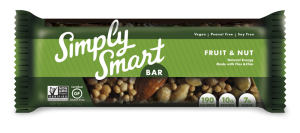 Simply Smart and Smart Kids snack bars are targeted directly at the nutrition-conscious, with Smart Kids bars formulated to meet U.S. Department of Agriculture requirements for school lunch programs. Simply Smart is the adult version, targeted at the consumer aged 16 and older who wants a healthy snack bar. Simply Smart bars contain no added refined sugar and contain 190 to 200 calories and 10 grams of protein per bar. “Everything we do is all-natural, Non-GMO Project Verified and certified gluten free,” said Chief Operating Officer Rob Zelickman. Simply Smart bars are packaged for individual sale at retail and sell for $1.99 each. The Smart Kids bars sell for $1.30.
Simply Smart and Smart Kids snack bars are targeted directly at the nutrition-conscious, with Smart Kids bars formulated to meet U.S. Department of Agriculture requirements for school lunch programs. Simply Smart is the adult version, targeted at the consumer aged 16 and older who wants a healthy snack bar. Simply Smart bars contain no added refined sugar and contain 190 to 200 calories and 10 grams of protein per bar. “Everything we do is all-natural, Non-GMO Project Verified and certified gluten free,” said Chief Operating Officer Rob Zelickman. Simply Smart bars are packaged for individual sale at retail and sell for $1.99 each. The Smart Kids bars sell for $1.30.
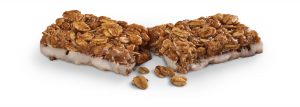 AWAKE Energy Granola Bars offer caffeine along with B vitamins and some added sugar for that late afternoon energy boost. Each bar contains as much caffeine as half a cup of coffee plus B vitamins. Each bar contains 5 grams of protein and 150 calories or less. They come in four flavors: Dark Chocolate Peanut Butter, Dark Chocolate Caramel, Coconut Apricot and Cinnamon Bun. They contain no artificial flavors or colors and are gluten free.
AWAKE Energy Granola Bars offer caffeine along with B vitamins and some added sugar for that late afternoon energy boost. Each bar contains as much caffeine as half a cup of coffee plus B vitamins. Each bar contains 5 grams of protein and 150 calories or less. They come in four flavors: Dark Chocolate Peanut Butter, Dark Chocolate Caramel, Coconut Apricot and Cinnamon Bun. They contain no artificial flavors or colors and are gluten free.
Peeled Snacks are designed to appeal to the consumer who looks for a clean ingredient deck with no added sugar. Peas Please are the newest item in the product line, which also includes Gently Dried Fruit and Apple Clusters. Made with 70 percent peas, brown rice, sunflower oil and salt, these crunchy snacks are all organic, Non-GMO Project Verified, and gluten free. They come in four flavors, with White Cheddar the newest. Other flavors are Sea Salt, Garden Herb and Southwest Spice. Peas Please are made by a certified B Corporation started in 2005. A 3.3-ounce bag that provides 3-1/2 servings of vegetables per bag sells for $2.99.
Snack pastries from Bakerly are for those who start their snacking with breakfast. Four product lines of bakery products include authentic French crepes filled with strawberry or chocolate, mini brioche, and a chocolate croissant. They’re made with real eggs and real butter, individually wrapped and delivered frozen to stores for a 30-day shelf life after thawing. “We are the only brioche to go available in the market,” said Damien Callery, the company’s Vice President of Sales. The products are made in France with clean recipes and no genetically modified ingredients. The newest in the line is a chocolate filled petit cake – something like a standard American-style snack cake but without all the artificial ingredients, Callery said. “We want America to go back to an American tradition, but with clean ingredients and better quality,” he added.
The bakerly petit cakes contain no preservatives, no high fructose corn syrup and no palm oil. They’re non-GMO. They come in three flavors: chocolate, apricot and strawberry, with all-natural fruit fillings. A package of five individually-wrapped cakes has a three-month shelf life and retails for $3.49.

